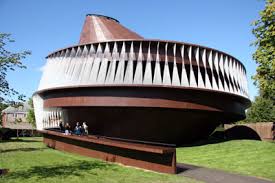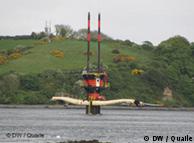Strange things have been happening to England. Still reeling from the dissolution of the empire in the years following World War II, now the English find they are not even British. As the cherished “United Kingdom” breaks into its constituent parts, Scots are clearly Scottish and the Welsh, Welsh. But who exactly are the English? What’s left of them, with everything but the southern half of their island taken away?
Going back in time to trace roots doesn’t help. First came the Celts, then the Romans, then Angles, Saxons, Jutes, Danes. Invasion after invasion, until the Norman Conquest. English national identity only seemed to find its feet later, on the shifting sands of expansionism, from Elizabethan times onwards. The empire seemed to seal it. But now there’s just England, half of a green island in the northern seas, lashed by rain, scarred by two centuries of vicious industrialization fallen into dereliction, ruined, as D. H. Lawrence thought, by “the tragedy of ugliness,” its abominable architecture.
Of all English institutions, the one to count on would surely be the pub. Shelter to Chaucer’s pilgrims, home to Falstaff and Hal, throne of felicity to Dr. Johnson, the pub — that smoky, yeasty den of jollity — is the womb of Englishness, if anywhere is. Yet in the midst of this national identity crisis, the pub, the mainstay of English life, a staff driven down into the sump of history, old as the Saxons, is suddenly dying and evolving at equal rates. Closing at something like a rate of more than three a day, pubs have become scarce enough that for the first time since the Domesday Book, more than half the villages in England no longer have one. It’s a rare pub that still thrives, or even limps on, by being what it was meant to be: a drinking establishment. The old idea of a pub as a place for a “session,” a lengthy, restful, increasingly tipsy evening of swigging, is all but defunct.
To take a measure of the current state of the traditional English pub — or whatever is left of it — I decided this spring to revisit a corner of the northeast Cotswolds where I misspent my youth, an area littered with picturesque towns and villages, and studded — as I remembered it — with lovely pubs. What, I wondered, has happened to them?
Chipping Norton, about 20 miles northwest of Oxford, is a classic Cotswold market town, faced in gorgeous stone, its market square tilted down the side of a hill, with, in the bottom of the dale it overlooks, a splendid old wool mill famous for its massively tall chimney. The town’s liveliest and best-known pub is the Chequers, a chain of small rooms dense with conviviality.
But the pub I’m here for is one that ought to be a dying breed.
JUST up the hill from the main square is the Red Lion. It’s a real old market-town pub: just one small main room, and one old geezer on a bench (the night I visited) sipping slowly on pint after pint, a fire gently hissing away, and a lively and lissome barmaid joking with a couple of young men at the bar. And nothing on offer but drink. (At lunchtime you might be lucky enough to get a cheese roll.) This is a pub that has made no compromise with the times. The brown linoleum floor, the mix of tables, the darts board, the Aunt Sally at the back (a peculiarly delightful game played only in Oxfordshire and three neighboring shires, involving wooden battens, a clay pot and a lot of tipsy near-misses) — this place can hardly have changed since the ’70s, or even the ’50s. The creed might be: If the beer’s kept well, the pub is delivering itself of its chief charge.
This one limps on, surviving on big turnouts on market days in the town square just 50 yards away, and on the fact that it’s one of four dozen pubs owned by Hook Norton Brewery. I suppose the brewery can afford the odd sleeper.
The little neighboring town of Hook Norton sheds its light all over this region. It is famous because its beer is famous. A small independent brewery has somehow not just survived but grown; it is an extraordinary Tudor-style tower six stories high, built in the 1880s on the edge of town, still powered primarily by a magnificent steam engine on the ground floor.
Hook Norton is my own favorite ale. There are two mainstay brews, Hooky and Old Hooky, the second stronger than the first, and a rotating array of seasonal brews. Both have that magical hazel clarity, a dark gold color, that is the very hallmark of the English countryside, and both have the same marvelous taste that I never seem to find in any other beer.
I’ve often wondered if I only love it as much as I do because it was the first beer I ever knew. My mother used to buy the old brown pint bottles of it, and keep a few in the larder. As teenagers we were encouraged to crack one open and pour the frothy, nutty, limpid stream into glasses at lunchtime, to help down a slice of bread and Cheddar: a feeding just like the medieval yeomen’s, who plowed the ridge-and-furrow still visible as undulations in the fields around our house.
But time after time, no matter how long since I last tasted it, Hook Norton seems to me rich and balanced as no other beer on earth.
“They say it’s in the liquor,” said Duncan Collins, retail manager at the brewery, when I visited a few months ago. “That’s the spring water that goes into it. But I honestly don’t know.”
He took me up the various floors, past the vats and tanks where the beer is first brewed, then fermented, up to the very top, to a kind of dovecotelike attic surrounded by louvered shutters, with a giant copper pool where until two years ago the beer was always pumped up to cool off. In a far corner of the next field the brewery’s Shire horses with their shaggy fetlocks were grazing. The brewery still uses them to pull a dray that delivers to the local pubs.
One of these, on Hook Norton High Street, is the Sun Inn. Why is a nice pub so nice? Take the Sun at a lunchtime. There’s a table of four, another of seven, and several lads at the bar. It’s like being at a mellow party, where you don’t have to chat if you don’t feel like it. There’s conversation about gardening — “Well, I always rotate” — and some kind of serious local historical talk: “You see, the problem was they just had no means of support.”
There are the spacious stripped wood tables, the milky light coming through the frosted windows and the fire smoldering across the room. And my big plate of fresh fish and chips (for the equivalent of $15) is sumptuous. Amid the low murmur of relaxed conversation you can feel the easy comfort, the happiness, of human beings at rest. And with the old plow tackle hanging from the ceiling, and the flagstone floor, and the bushy hops among the beams, there’s a sense of history’s being a friend, of this means of relaxation’s being sanctioned and endorsed through having been enjoyed for centuries. You sense it’s true that Europeans — even the English — still know how to live.
At the Pear Tree Inn nearby, also one of the Hook Norton Brewery pubs, festoons of hops hang above the bar, from the dark beams of the low ceiling. A fire hisses in the stone fireplace, releasing a tang of woodsmoke into the air. Outside, pressed almost into the 18th-century brickwork of this simple, sweet pub, the eponymous pear tree grows up the building. There’s a big garden at the back, to make up for the relatively cramped interior. It’s a true classic, just at the end of the lane from the brewery. I doubt you could walk in here and not feel better, no matter what you’re going through. The very air is thick with over 200 years of soul-soothing. It’s everything a pub should be: a fabric of mercy, a haven from the preoccupations of post-industrial life, a timeless space more connected with the fields and springs, the repeating cycle of generations, than with the particular troubles of our own times. It has been softened by the goodwill of different eras.
Right here you feel the truth of what The Good Pub Guide has to say: that in a good pub, “you should feel not just glad that you’ve come, but that they’re glad you’ve come.” What is that magic ingredient? They say a pub can have every attribute, but if the host or hostess isn’t quite right, it won’t come off. It all comes down to the proprietors.
Ironically, as England’s wealth is generated ever more in the cities, the tastes of the wealthy seem to become ever more rural. There’s a strange symbiosis happening between “green” as lifestyle statement, and a kind of retro-medievalism. Stripped neo-medieval floorboards, flagstones, thatch if possible, and food and drink that reflects the medieval and inherently rural heritage — perhaps it’s here that the nation’s identity might be secured. The more local the fare the better, no matter if the consumers are thudding 100 miles to lunch and back in gas-guzzling Land Rovers. That’s the recipe these days.
This is the formula of the Kingham Plough, in the nearby town of Kingham, a pub that has actually won a Michelin star. Its young chef Emily Watkins was a protégée of Heston Blumenthal, the mad scientist of cuisine, and has her own water baths for cooking protein with sublime accuracy — “48 degrees,” our waiter tells us of the halibut, speaking in centigrade, “and 54 for the mutton loin.”
Alongside the science, there’s the neo-medieval thing. “We buy whole beasts,” the chef tells me. “Trotter to snout.” It’s then I discover I’ve just eaten pig’s head for my starter, a kind of patty called “Pressed Pork” that I took to be something like “pulled pork.” Far from it: it’s boiled-down head. This might be a vegetarian’s nightmare, but the slab of 48-degree halibut was meltingly flawless, and my super-rich mutton faggot, wrapped in a Savoy leaf to resemble a miniature cabbage, was wonderfully dense, juicy and aromatic — it was actually a mix of breast and minced offal, slow-braised for hours. They brine pork in Hook Norton ale here, and cure it in the chimney, following a Victorian recipe of a landlord of this very pub.
MOST of the pub is turned over to the restaurant, but in one large stone room you can sit and drink rather than eat, should you want to. They have several beers on tap, including the local star Hook Norton, and there’s a large and intriguing bar menu. In spite of the elevated cuisine being served, the atmosphere throughout is more like a bistro or brasserie — a kind of cleaned-up pub, with the stonework washed, and the flagstones regularly swept.
No tour of the Cotswolds — at least no tour taken by any pub lover — would be complete without a visit to the village of Great Tew, a once-abandoned and derelict medieval village with a crumbling great house, now revived, rethatched, repopulated and re-energized, with a school, a shop and a splendid pub, the Falkland Arms. Only the magnificent frigid church remains deserted and sadly neglected.
Twenty-five years ago, one of the few edifices still occupied was the village pub. As I recall, two old men were always there, one either side of the bar. It was like stepping into a King Arthur movie — the stone floor, the soot-blackened beams, the wooden bar offering two draft beers, and a row of dusty demi-johns of homemade wines: damson, plum, pear. The dirty gray thatch on the roof was tattered and molting. Today, there’s a liveried chef in the modern kitchen, the thatch is golden, and the place has gone like the village: into the glossy magazine world of lifestyle asset for the middle classes. It may have lost some of its authenticity, but it’s still a charming place, with a lush garden overlooking the glorious hillsides of the far northern reach of the Cotswold Hills, and high-quality food.
It also has a good selection of beers, including three from Wadworth, the company that now owns the pub — the famous 6X beer, Horizon Ale and Henry’s I.P.A. A further three beer pumps at the bar are available for guest beers such as Gravitas from the Vale Brewery in nearby Buckinghamshire. Hundreds of tags around the bar attest to the different guest beers they’ve had over the years. (If you want to taste a few before deciding on a pint, they have special tasting glasses.) As the pub advertises on its Web site: “Real Ale, Real Food, Real People. Real Pub.”
To round off my tour of former haunts, I found my way to the King’s Head, just off the village green of Bledington, set in a 16th-century cider house, which has now been stripped down to a simple stone-and-wood interior bespeaking the kind of quality fashionable today. Along with Hooky it has Notley Ale on draft, from the Vale Brewery just east of Oxford, as well as a sophisticated menu and 15 bedrooms. There’s a cozy stone-walled room at the back, and a large dining room with low wood beams. (Take care when you leave the pub, especially if you’ve had a very convivial evening: the village green outside has an unusual arrangement of small canals cut through it.)
If pubs are either dying or transforming back to what some of them once were — places offering food and bed, like the old coaching inns (the inn of yore being the pub of today) — it’s reassuring to find that so much charm has been preserved, that the ale is as good as ever, and that you can get a tremendous meal besides.
SERVING TRADITION BY THE GLASS
North Oxfordshire lies in the far northeast corner of the Cotswold hills. It’s an area best explored by car, and lies roughly a one-to-two-hour drive from London. The M40 motorway is the most direct route.
There is regular train service from Paddington Station in London to Banbury, and to Kingham, some 15 miles to the southwest, and also (via Reading) from Gatwick Airport.
WHERE TO DRINK
The Red Lion, Albion Street, Chipping Norton; (44-1608) 644-641. Opening times: Monday through Friday, 11 a.m. to 2 p.m. and 5:30 to 11 p.m.; Saturday, 11 a.m. to 11 p.m.; Sunday, noon to 11 p.m. Price of a pint: £2.70 (or $4.43 at $1.64 to the pound) for a Hooky Best; £2.20 for Roaring Lion, the house bitter.
The Sun Inn, High Street, Hook Norton; (44-1608) 737-570. Opening times: weekdays 11:30 a.m. to 3 p.m. and 6 to 11 p.m. (till midnight on Fridays); Saturdays, 11:30 a.m. to midnight; Sundays, noon to 10:30 p.m. Price of a pint: £2.70 for an Old Hooky.
The Pear Tree Inn, Scotland End, Hook Norton; (44-1608) 737-482. Opening times: daily, 11 a.m. to 1:30 a.m. Price of a pint: the Pear Tree has six different Hook Norton ales, ranging in price from £2.30 (for a Hooky Dark) to £2.80 for one of the seasonal beers of the month.
The Kingham Plough, village green, Kingham; (44-1608) 658-327. Opening times: daily, noon to 11 p.m. (10:30 on Sundays). Price of a pint: £2.80 for a Hereford Pale Ale, £3.20 for a Cotswold Ale.
The Falkland Arms, Great Tew; (44-1608) 683-653. Opening times: Monday through Friday, 11:30 a.m. to 3 p.m. and 6 to 11 p.m.; Saturday, 11.30 a.m. to midnight; Sunday, noon to 10.30 p.m. Price of a pint: £2.90 for a Wadworth’s 6X.
The King’s Head Inn, the green, Bledington; (44-1608) 658-365. Opening times: weekdays, noon to 3 p.m. and 6 to 11:30 p.m.; weekends, 11 a.m. to midnight. Price of a pint: £2.90 for a guest Organic Stroud Ale.
HENRY SHUKMAN, an English novelist and poet who now lives in New Mexico, is a frequent contributor to the Travel section. His novel “The Lost City” was published in May by Vintage.













